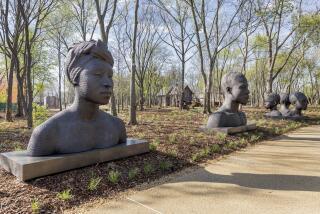Where Slavery, Freedom Met
- Share via
PHILADELPHIA — When visitors walk through the new $9-million pavilion housing one of the nation’s most enduring icons of freedom, they will tread above the spot where the first president kept his slaves.
But even before the Liberty Bell Center opens in 2003, a debate is brewing over how best to treat the place where slavery and freedom coexisted.
Some historians say building the center’s entrance just beyond the site of George Washington’s slave quarters is tantamount to burying history--both literally and symbolically. The National Park Service argues that the underground structure, yards from the bell that became a symbol of the abolitionist movement, has to be covered over to be preserved.
“If it’s not going to be destroyed, the best preservation is to leave it in place--that’s standard practice and one of the tenets of archeology,” Park Service spokesman Phil Sheridan said. “Excavating it can mean you have to destroy it.”
However, critics say it appears that the government is avoiding the obvious contradiction of freedom and servitude. They want the Park Service to halt construction and perform an extensive archeological evaluation, although they say there are no plans to force the issue with a lawsuit.
“Our historical memory is often managed and manipulated, [but] it’s downright being murdered in Philadelphia,” said Gary B. Nash, a UCLA history professor and a scholar of the Revolution.
The Park Service says it already has done excavation work and recovered thousands of artifacts. The slave quarters were untouched.
“The excavation was very thorough....We looked at everything we could have looked at,” added Rebecca Yamin of John Milner Associates, which did the work.
The Liberty Bell Center is part of a $300-million redesign of Independence Mall that includes the new Independence Visitor’s Center and the under-construction National Constitution Center.
The new center is just steps from where the Liberty Bell has been displayed in a glass pavilion since 1976. It attracts 1.6 million visitors a year.
At the very least, the Independence Hall Assn., a watchdog group, wants a memorial, perhaps an outline marking the house where Washington once lived.
City officials also want some sort of commemoration, said Frank Keel, spokesman for Mayor John F. Street, adding that it was “too early to determine whether excavation can or cannot happen.”
Washington’s house was a red-brick mansion at 6th and Market (then called High) streets, where the founding father conducted the nation’s business. It’s also where he brought eight slaves from Mount Vernon, including his cook, Hercules, and Martha Washington’s personal servant, Oney Judge, who eventually fled those now-buried slave quarters and gained their own freedom.
Washington’s successor, John Adams, also used the home during Philadelphia’s time as the national capital, from 1790 to 1800, before moving to Washington, D.C.
In 1951, the remains of the house were demolished to make way for Independence Mall.
More to Read
Sign up for The Wild
We’ll help you find the best places to hike, bike and run, as well as the perfect silent spots for meditation and yoga.
You may occasionally receive promotional content from the Los Angeles Times.






